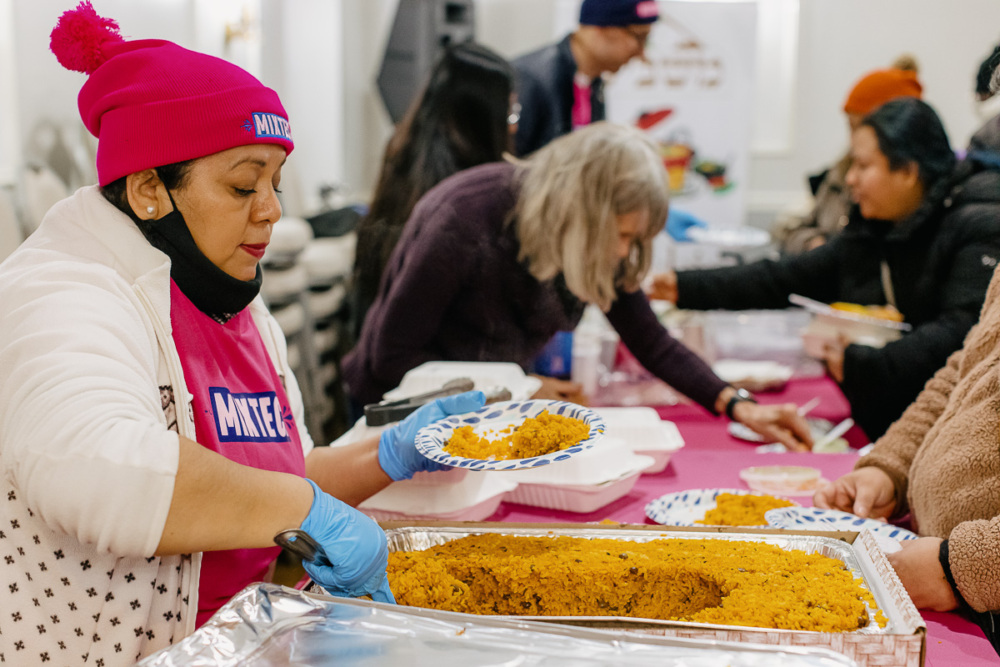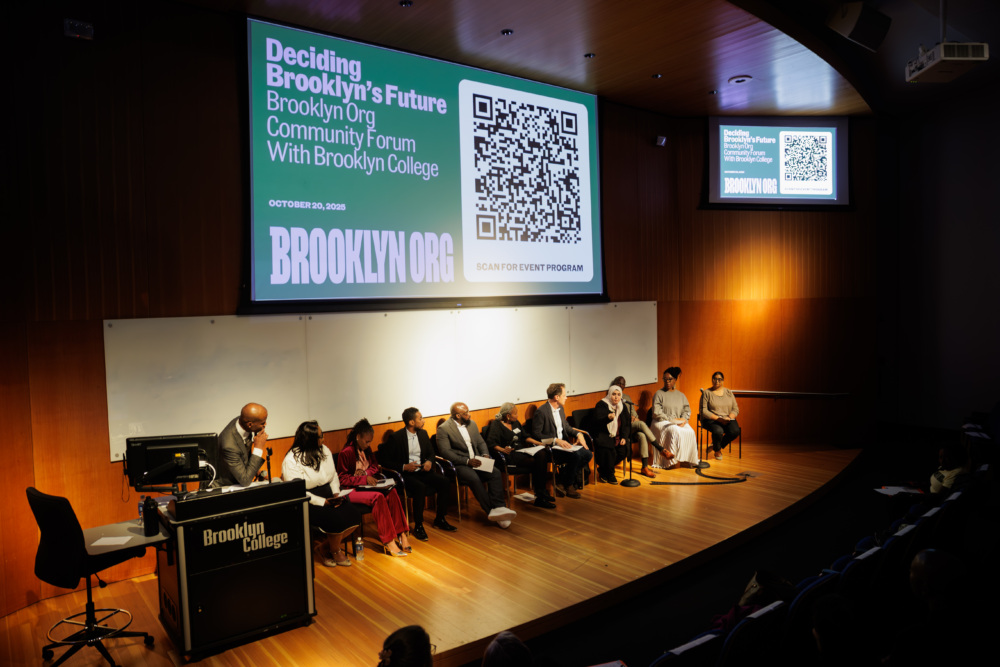New Survey Finds Brooklyn Nonprofits Struggling to Keep Up with Rising Costs, Growing Demand, and Funding Cuts

This article was co-produced and co-published with Proximate.
Who gets to make the decisions about where philanthropic dollars go?
For a long time, the conventional wisdom was that grantmaking should rely on professional staff to make expert decisions, reflecting philanthropy’s move from a values-based tradition to a more technocratic bent. But even a decade ago, the limitations of what came to be called “strategic philanthropy” were evident. Trust in institutions—including philanthropy—began declining dramatically, opening the door for more public critique of foundations and big-dollar donors as elitist, nontransparent, and plutocratic.
On top of this, there was a pandemic and a worldwide racial justice movement that demanded change in who made grants and how. This led to calls for philanthropy to acknowledge the (often exploitative) origins of their wealth (as some funders have done) and demanded shifting the power to make funding decisions to community partners.
Perhaps not surprisingly, this movement has begun to generate a backlash. A prominent example appeared last December when the Manhattan Institute’s magazine, City Journal, published an op-ed titled “Just Trust Us,” a blistering critique of trust-based philanthropy (TBP) by James Piereson and Naomi Schaefer Riley. This seems to be the start of a trend: another article taking similar aim appeared in the Chronicle of Philanthropy in January.
[Trust-based philanthropy]…is rooted in a set of values that advance equity, shift power, and build mutually accountable relationships.
Piereson and Schaefer Riley aim to discredit the rise of grantmaking models that shift power and trust to grantees—from loosening reporting requirements to shifting decisions over grant funding outside foundations’ walls.
Unfortunately, in making their argument the authors reveal what happens when so-called experts make assumptions about an issue rather than consulting those closest to it—in this case, trust-based and participatory grantmakers. Had the authors been as careful in applying their version of due diligence to their own public pronouncements, their characterization of TBP may have been more accurate.
Before we respond, we should underscore that the three of us share Piereson and Schaefer Riley’s view that philanthropy should meaningfully support organizations doing important work. All of us have worked at both foundations and nonprofits in various capacities and know the value of the support, financial and otherwise, that donors provide.
We’ve also been passionate critics of traditional (especially institutional) philanthropy. Ironically, so have the authors. The neoconservative movement of which Piereson and Schaefer Riley are a part grew out of an aversion to “bigness”—centralization, professionalization, and elitism. That philosophy has percolated in their own critiques of establishment philanthropy, which has historically relied on well-credentialed policy, government, and academic experts to solve social problems rather than relying on the immense reserve of local wisdom and practical experience.
We still strongly disagree, however, on several points raised in this article.
First, the authors’ characterization of TBP is inaccurate. To set the record straight, TBP is an approach to philanthropy that attempts to address power imbalances between foundations and nonprofits and is rooted in a set of values that advance equity, shift power, and build mutually accountable relationships.
Those values aren’t just a “vibe.” They are operationalized through multiyear unrestricted funding; streamlined applications and reporting; and a commitment to transparency, dialogue, relationship building, and mutual learning. There’s a lot more to the definition of TBP, in other words, than giving money “without strings attached.”
The authors also conflate TBP with other approaches attempting to challenge the top-down decision-making systems that have dismissed or ignored “real people”—the same people who struggle daily with racism, poverty, and related challenges, and who usually have the best ideas for addressing them. That requires sharing and even ceding decision-making power to those communities, but the way that’s done isn’t limited to TBP.
Participatory grantmaking, for example, is similar to TBP but adds one thing to the mix—ceding some or all power over funding decisions to community groups. Piereson and Schaefer Riley also miss other nuances. For example, giving circles are a participatory approach in which people come together, pool their dollars, and decide together where to give money and other resources. A related approach is giving projects which, by design, are structured to have a cross-class, cross-race membership.
These kinds of efforts democratize what has historically been the purview of “experts” and other gatekeepers. They also challenge the notion that “all giving is good” and have called philanthropy to account for “structures that perpetuate inequality and reinforce the social advantages of the wealthy”—or as Piereson and Schaefer Riley might suggest, the elite.
Finally, the authors confuse what we see as community consultation—relying on grantees for advice (which is often disregarded)—and what we would call authentic participation. Although grantees may provide feedback or advice for donors, that’s hardly evidence of taking their experience and knowledge seriously since the people asking for that feedback are still making the ultimate decisions about the lives of the people providing it. Nor is there any accountability system to track whether their advice is taken.
The result is a loop back to the top-down, expert-driven system that’s ingrained in traditional institutions, including foundations—the same kind of systems that neoconservative writers once critiqued.
Beyond these definitional issues, we have a bigger disagreement with the authors’ rationale for due diligence: “to make sure [donors’] own purposes are carried out and to prevent those institutions from taking them for granted.”
The authors’ main argument is that TBP is a disavowal of donors’ responsibility—and their right—to perform due diligence on grantees. By shifting power to communities, donors are neglecting due diligence, which puts them at risk of funding the “wrong thing”—or, even worse, of not seeing their own philanthropic visions carried out.
First, they imply that funders engaging in TBP and other participatory approaches to grantmaking are absolving themselves from any responsibility in that process. They point as an example to the perceived failure and misspending of Black Lives Matter, which they accuse of having seen hundreds of millions of dollars “wasted or stolen.”
It’s worth pointing out that Black Lives Matter is a decentralized movement that includes localized chapters, unaffiliated individuals, and more formal organizations that together have had a world-changing impact, as illustrated by the 20-million-plus people who joined demonstrations in the United States alone in 2020.
If the authors are referring to grants made to the Black Lives Matter Global Network Foundation, a small-staffed organization that raised $90 million in their first year—yes, mistakes were made, but they’ve since been accounted for publicly. Check their website, which shows their 990s, audited financials, and responses to the financial questions the authors obliquely reference.
But the larger point is that even when philanthropic institutions use TBP and other participatory approaches, they still have to adhere to externally imposed legal and fiduciary regulations and policies. And that, we agree, requires adequate due diligence and a shared understanding of goals and potential results. By devoting ample time to getting to know an organization up front through conversation, program observation, review of financials and connection to field partners, a trust-based funder can contribute capital and then be available in ways that are useful to the grant partner. We believe that this kind of support, rather than the imposition of intrusive and time-and-energy-sapping requirements, helps to meet the mission.
The authors make a second, more surprising argument—that TBP prevents donors from seeing their own philanthropic vision realized. They point to recent stories of alumni pulling funds from Harvard and other Ivy League schools as examples of donors exercising their due diligence “after the fact,” and say that TBP undermines donors’ efforts to “make sure [their] own purposes are carried out” and to “prevent those institutions from taking them for granted.”
What’s missing is the role of the community in defining and shaping the purpose for which grants are made. If a donor actually cares about the success of an organization, their support should be predicated on a common mission for its end purpose, not to enact their personal goals, nor to be personally appreciated—a position we believe to be the very definition of elitism.
That gets us to the donor’s role—another area in which we disagree. Yes, TBP and other participatory approaches are “blurring the line between donor and grantee.” That’s intentional not only for the reasons outlined above but also because foundation funds are effectively funds that are stewarded on the public’s behalf because they aren’t taxed. Thus, foundations have a responsibility to be accountable to and work in partnership with the public.
Finally, since the three of us are all connected to foundations in one way or another, we’d be remiss if we didn’t offer our own experiences with TBP and other forms of participatory philanthropy.
The Robert Sterling Clark Foundation, where Cowan is a vice president, has practiced TBP over the past six years including by providing multiyear general operating support grants. This has enabled the foundation to assist grantees more effectively in their work—whether they have program dilemmas, are looking for new partnerships, or have financial challenges that the foundation can help them work through. We believe this is a better contribution to the foundation’s mission than having grantees show up once a year to praise, punish, or take away.
Brooklyn Org (previously Brooklyn Community Foundation), which Rainey leads, has used TBP for most of its existence. During Covid, using TBP helped the foundation provide first-time funding to 137 new organizations (out of a total of 214), making sure that many people who would have otherwise “slipped through the cracks” could get vitally needed support. The group’s recent rename to Brooklyn Org is a reflection that the foundation is a philanthropy for—and informed by—the community.
One of the most important things Brooklyn Org has learned from its grantee partners and the communities they serve is that community needs change and grow, so the best way its funding can meet those needs is to help those organizations—which often have small budgets and staffs—be ready for them. That means focusing less on metrics and grant reporting that detracts from nonprofits’ actual work, and more on getting to know them and their communities so the foundation can provide support “beyond the check”—investing in real partnerships and providing robust networking and capacity building programs that make nonprofits stronger so that they can be as accountable as possible to their communities and donors.
During Covid, using [trust-based philanthropy] helped the foundation provide first-time funding to 137 new organizations (out of a total of 214).
Even large foundations, despite organizational complexity, are finding ways to embed TBP and other participatory practices in their work.
One author’s work with national foundations has shown that several are incorporating many of the practices referenced here: providing more multiyear general operating support; streamlining reporting and excessive metric gathering; and engaging in participatory strategy development and participatory grantmaking—a shift we believe can be directly attributed to the TBP and participatory grantmaking movements.
That’s not anecdotal; there’s data behind it. A recent set of data points came out of a recent survey of donor collaboratives by Bridgespan, which found that 39 percent report using “participatory mechanisms” to make grant funding decisions, while 47 percent offer unrestricted capital. These collaboratives are often an outlet for larger foundations to try out new models, and we hope these experiments encourage them to take these practices in-house.
Another study examining the degree to which large US foundations have incorporated stakeholder participation in their governance and grantmaking, by Kelly Husted, Emily Finchum-Mason, and David Suárez from the University of Washington, found that 83 percent directly engage stakeholders—grantee nonprofits, nongrantee nonprofits and community-based organizations, community members affected by the foundation’s funding, or members of the public—to some degree in their governance or grantmaking. Given Piereson and Schaefer Riley’s insinuation that foundations that employ TBP and other participatory approaches shirk due diligence, it’s noteworthy that 80 percent of respondents in that study said participatory practices led to increased grantmaking effectiveness and 66 percent said these practices also helped generate more innovative solutions to social challenges.
In closing, there’s no question that the practice of philanthropy is more art than science, and since there are few sector-wide rules or guidelines beyond those of the IRS, it is open to interpretation.
However, given the oft-cited truism that philanthropic money is generally twice stolen (in that it’s frequently derived from worker exploitation, race-based oppression, or countless other unethical means—and then taken out of our tax streams), we believe it’s incumbent on philanthropy to exercise its responsibility of returning resources to communities with great respect and deep listening. Among other things, this requires committing to seeing community members as the real experts in finding ways to tackle the problems they face every day—and then giving them the resources to implement the solutions they see as priorities.
Trust-based philanthropy, participatory grantmaking, giving circles, and other forms of participatory philanthropy are structured, rigorous, and effective strategies to do this. As such, they deserve, at the very least, more exploration before they are categorically dismissed.
It’s incumbent on philanthropy to exercise its responsibility of returning resources to communities with great respect and deep listening.

